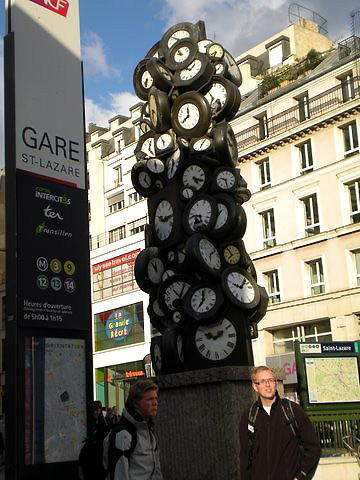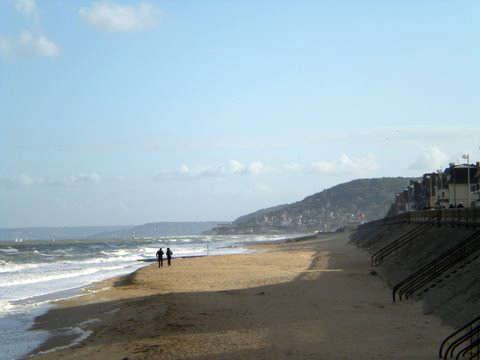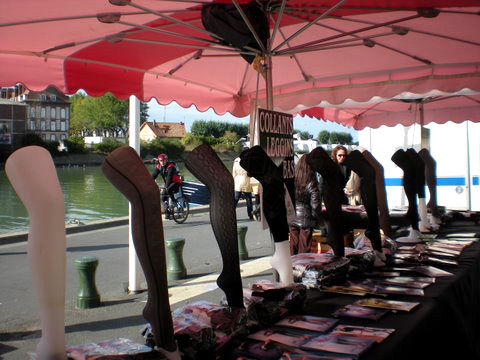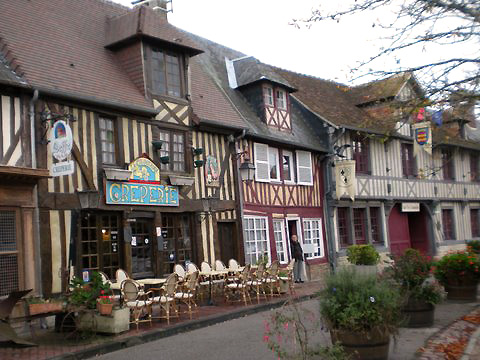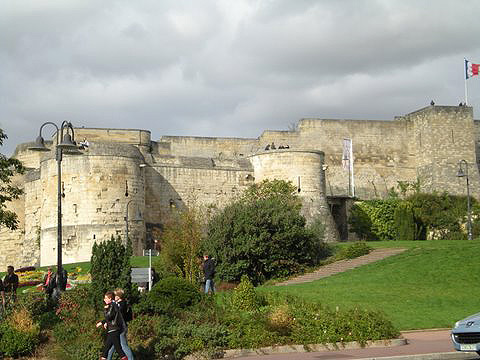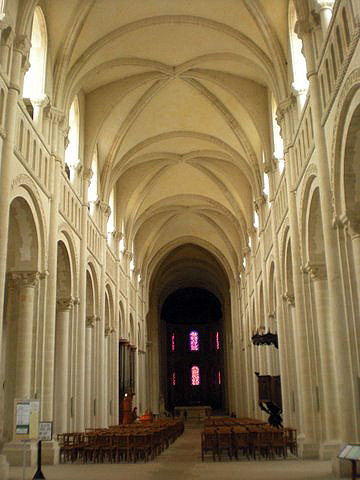 |
 |
|
 |

|
Normandy
by Corinna Lothar Trouville, Normandy
There is much to discover in Normandy. To the south, there is the Mont St. Michel, that spectacular rock around which the sea swirls at high tide and atop which perches a medieval abbey, reached by climbing steep, winding streets, now lined with shops and restaurants. In the northeastern section of Normandy lies the enchanting fishing village of Honfleur with its colorful rectangular port and the oldest wooden church in France. The stunning chalk cliffs and chalk needle of Etretat bring to mind the white cliffs of Dover. Further inland is the city of Rouen where Joan of Arc was tried and burned at the stake in the city’s central square. Monet painted the façade of Rouen’s cathedral 30 times.
Throughout the region, there are magnificent abbeys, some in ruins, some intact. There are churches and bourgeois mansions and half-timbered farmhouses. Museums abound. Normandy, after all, was the birthplace of impressionism. But we concentrate on the central part of Normandy, the northern beaches and the lovely “pays d’Auge.” The train glides from the busy bustle of the Gare St. Lazare in Paris through fertile fields en route to the quaint little station serving the twin towns of Trouville and Deauville, on the northern coast. Paris, only two hours away, has left its mark on Deauville, the still-elegant seaside vacationing spot built in the nineteenth century by three aristocrats. The town is full of impressive turn-of-the century villas and a splendid half-timbered hotel, the Normandy, serving the monied clientele. The long wooden boardwalk, a casino and racecourse were added in 1910 and the town quickly became the playground of the Parisian uppercrust.
Deauville is still stylish and the place where many Parisians have summer and weekend homes. In fall and winter, the colorful umbrellas on the wide beach are furled and removed until the warmer days of spring return, but the seafront promenade remains a wonderful place for a healthy stroll in a brisk wind. Deauville has a market where the region’s bounty is displayed, from gleaming fresh fish to creamy rounds of Camembert cheese. Every September, Deauville hosts an American film festival and the town is awash in celebrities of various calibre. The citizens of Deauville have always looked down their Gallic noses at neighboring Trouville-sur-Mer, separated from its twin by the Touques River. Trouville is the older of the two towns. Its beaches were immortalized by the French impressionist painters, and in the film “Gigi.” An air of informality reigns in the narrow streets and along the waterfront where the huge and colorful Sunday market takes place.
Trouville is more fun than its elegant sister across the Touques. It too has a casino and a boardwalk, as well as an aquarium and busy fishing port. You can enjoy moules-frites (mussels and French fries) at one of the outdoor cafes along the waterfront boulevard, and wash them down with a glass or two of hard cider (“cidre”in French) and a little “Calva” to finish. It’s hard to visualize the carnage that took place on the wide sandy expanses of Normandy’s beaches in early June of 1944. The French call the D-Day landing “le debarquement.” Nothing is left of the material of war except for the remarkable artificial harbor, built in England and floated to Normandy, now bobbing in the water like a giant spectre at the village of Arromanches, or perhaps the ghost ship of the Flying Dutchman. Standing on the cliffs looking down from the Pointe du Hoc, one can but marvel at the courage of the young American Rangers who scaled the cliff in the face of devastating German machine gun fire. The American Cemetery in Colleville-sur-Mer contains almost 1,000 graves. It is a serene place of beauty and sadness. The French government in a gracious gesture, has given the land in perpetuity to the United States so that the soldiers who lie there rest in American soil. There are smaller cemeteries throughout the region where Allied soldiers lie, as well as German cemeteries with their dark stone crosses. It is relatively easy to tour the landing beaches and memorials. Signposts indicate the way and the local tourist offices have brochures and maps for visitors. Norman villages are particularly attractive with their half-timbered houses, flower gardens, weekly markets. Such villages as Beuvron-en-Auge and Beaumont-en-Auge in the lush Pays d’Auge seem untouched by time. Many of the villages have excellent restaurants, for example the Pave d’Auge in Beuvron-en Auge, La Mere Poulard in Mont St.Michel and La Ferme St. Simon in Honfleur. Cream, cider and calvados are incorporated into many of the dishes, and a cheese course is almost obligatory.
A typical Norman village is Camembert, origin of the famous cheese. Camembert (the cheese) is said to have originated in 1791 by Marie Harel who made the cheese with the help of a priest who came from the village of Brie. Marie gave the cheese the name of her village – not the other way around as tourists sometimes believe. Caen, the capital of lower Normandy, is a charming university town, much of it destroyed by fire during the fighting in Normandy in 1944. But the city has been carefully restored and is now a pleasant mix of the old and the new. When William of Normandy set out from France in 1066 to conquer England at the Battle of Hastings, it was from his hilltop royal home in Caen, which became a fortress in 1204. All that remains today of the Conqueror’s castle are the ramparts, the chapel and the great hall of Henry I of France. Like the ruins of William’s castle in East Yorkshire, the castle fortress in Caen is an imposing sight, hovering over the city. Inside the walls are lovely gardens and museums.
Caen’s most beautiful churches are the Abbaye-aux Hommes and the Abbaye-aux-Dames, built by William and his wife, Matilda, respectively. William and Matilda were cousins whose marriage was opposed by the pope. When the pope relented, each built an abbey as penance for their marriage. Matilda’s Women’s Abbey is a beautiful church with simple elegant lines, founded in 1063. The more imposing Men’s Abbey was founded by William in 1066 or a year later.
The Memorial Center for History is located on the outskirts of Caen. It is a museum dedicated to the history of the 20th century, with particular emphasis on the second world war. The museum shows a fascinating 30-minute film on the D-Day landing in which a split screen shows the Allies landing on one side of the screen with the German preparations and attempts to hold off the invasion on the other. Reservations can be made at the Memorial for guided tours of the landing beaches. Although William set forth from Caen on his journey of conquest, the famed tapestry recounting his voyage and battle with the Saxons is admired in the town of Bayeux. The 11th century tapestry is some 75 yards long, embroidered on linen. Itdepicts more than 600 men and women, 200 horses, 40 ships and hundreds of animals and mythological figures, all meticulously and splendidly drawn in hundreds of thousands of tiny stitches of thread. Bayeux was spared from destruction during World War II and retains its charming old town. It has lace and porcelain museums, as well as a D-Day museum and a British cemetery and memorial. Normandy also offers the more mundane pleasures of golf, horse racing and riding, gambling and, of course, enjoying some of the best cooking in France. Close enough to Paris for a day-trip, yet far enough for a summer holiday, the region of apple trees and cows is a feast of history, beauty and fine food. Small wonder it continues to draw artists to its vistas of sea, sand and the ghosts of tumults past.
WHEN YOU GO Most major carriers fly nonstop from both east and west coasts to Paris. Once in Paris, train service from the Gare St. Lazare to Trouville-Deauville, to Rouen or to Caen is frequent throughout the day. Rail tickets and passes for France and the rest of Europe can be obtained in the U.S. through RailEurope at 1-800-622-8600. Information on Normandy: |
I found a Mich Goss J. Grassmayr Innsbruck bell with Jesus,
a crucifix and a flower on it. Do you have any information about it you can
share with me? Many thanks. I don't have any information on that specific bell. If she wants information, "Liz" in San Bernardino should contact the factory. Here is the information: Address Grassmayr Foundry and Bell Museum, Leopoldstrasse 53, Inssbruck, A-6010 Austria. Telephone: 43 512-59416-0. Fax: 43 512-59416-22. E-mail: johannes@grassmayr.at or info@grassmayr.at. Corinna
Been there -- thought I'd done it -- you proved me wrong. Great travel coverage -- even for those who have lived there. --- Bill, Redmond, Oregon
Corinna, my dear, What a wonderful series of words you have collected together to paint a mesmerizing story about one of my favorite places. Even though I've traversed these same locales as you many times, your delightful descriptions made me want to book a flight this very second and see again some of the places that time did not allow me to linger in before. Your photos are also riveting, and I loved the pantyhose one - what a clever, sexy way to promote that article of the female form. Your colorful words make the entire region literally come alive before my eyes - a rare gift for any writer! Bravo and again Congrats on your top notch feature. Best regards. Best regards,
Hello Corinna, This is very roundabout ... I was recently teaching (Legal Reasoning) in Kabul and encountered Ann Geracimos, who said she knows you from the Times. She recently provided me with an electronic version of your 2007 piece about returning to Frankfurt (which I enjoyed very much). Jonelle and I are well (and enjoying our 3 grandchildren, who live within blocks of our house). I hope you are well. I will now look for your travel writing regularly. Best regards,
What an amazing background Ms. Lothar has! I enjoyed her article
very much. I found it to be quite intriguing, especially the interpreter school
bit.
I loved your article on Metz. I was an exchange student living there from 1981-1982 and have always felt like Lorraine was the most overlooked part of Europe. You really captured the feel of the city with your photo and articles.
|
This site is designed and maintained by WYNK Marketing. Send all technical issues to: support@wynkmarketing.com







